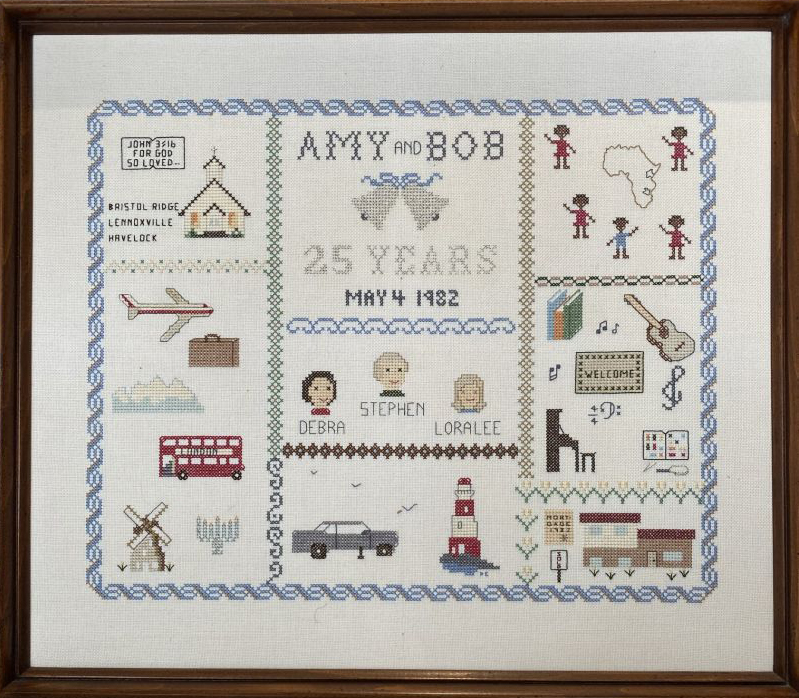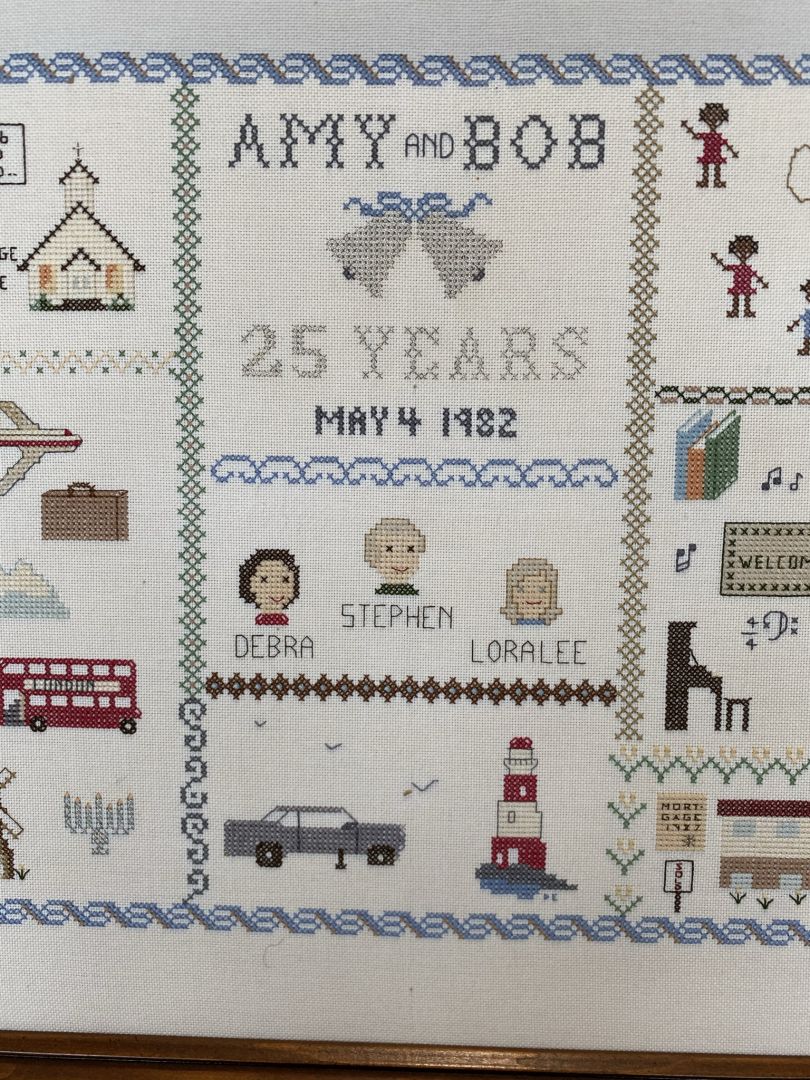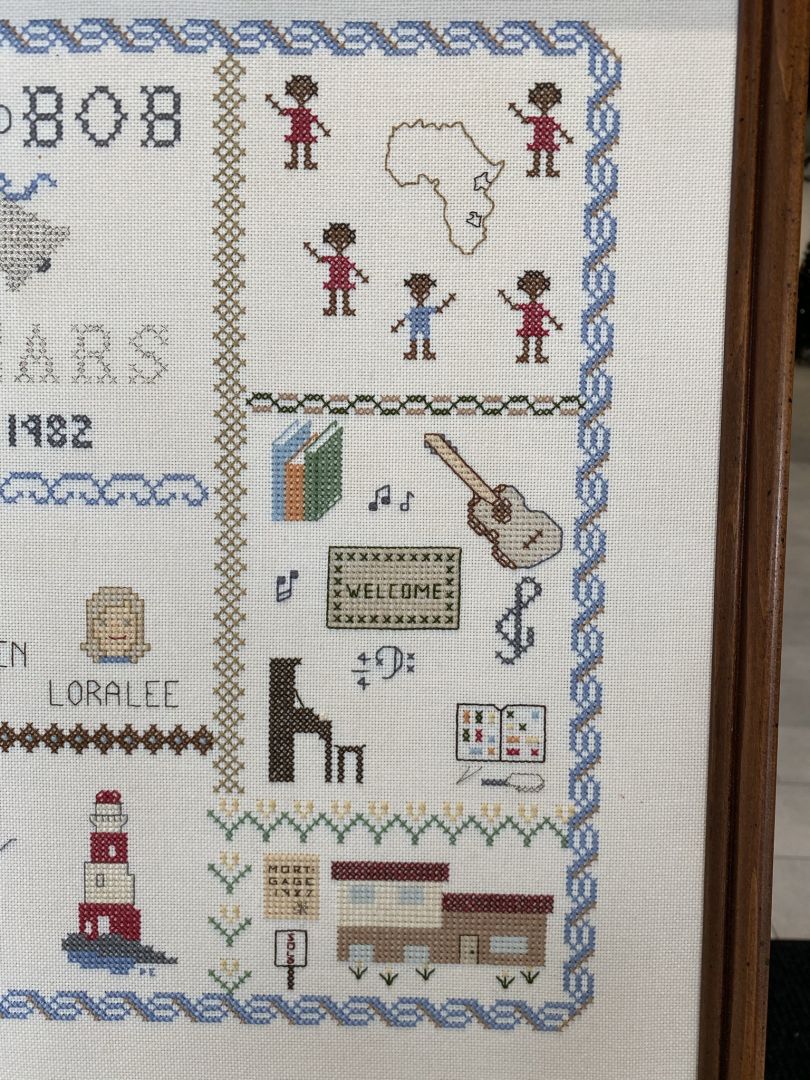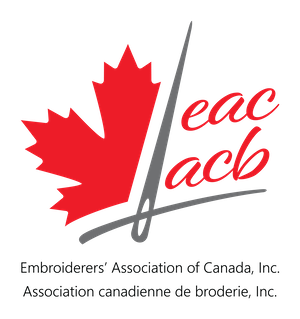Amy & Bob 25th Anniversary
Estimated Date Stitched:
1982
Estimated Age of Stitcher:
44
School and/or Teacher:
Name of Stitcher:
Dale Laura Edwards
Type of Sampler:
other*
*Anniversary
Size of Sampler:
Width: 53.3cm
Height: 45.7cm
✔ď¸ Framed
Description:
Stitched in uneven size blocks divided by scrolled borders. Each block depicts an aspect of their life.
Condition: Excellent
Description of condition:
In pristine condition. No stains, discolouration, or damage.
Fabric Type:
Cotton
Approximate thread count:
14
Embroidery thread type:
cotton
Number of letters:
Case:
Description of alphabets:
Number of sets of numerals:
Description of numerals:
Borders: other – various scrolled designs
Motifs: buildings, religiuos, family record
Type of stitches: Cross
Name or initials on sampler: Amy and Bob, Debra, Stephen, Loralee
Verse or Inscription:
25 years May 4 1982
John 3:16Â For God so loved
Welcome
Mortgage 1982Â Â SOLD
Owner / Donor Story:
A record of the first twenty-five years of the marriage of my sister and brother-in-law, Amy Ruth Cross and Robert Lenworth Seaboyer.
Sixteen months after marriage, he entered Eastern Pentecostal Bible College to become Reverend Robert Len worth Seaboyer. The little church at the top left represents the churches that he pastored during those years of ministry, with the names of their first three churches listed, Bristol Ridge, ON; Lennoxville QC, Havelock, ON. Although Amy did not attend the school or receive diplomas, she became his assistant and fellow in ministry, a beloved couple who always put others first wherever they served. The church is surmounted by probably the most beloved Bible verse ever, John 3:16
The next section, top to bottom, on the left, encompasses travels to and from mission stations, where they served with kindness and compassion, becoming a part of the people and learning to love them. Airlines and suitcases became a part of those years, visiting such places as Switzerland, represented by mountains, London by the big red bus, Holland by a windmill and Israel by the menorah.
The next, centre, section begins at the top with wedding bells, 25 years and the anniversary date, May 4, 1982.
Central to the whole sampler are their three children, a large part of their lives, always beloved by them.
Bottom centre, indicative of their place of birth, Nova Scotia, Canada – the lighthouse, shoreline and gulls. On the way from Ontario the old car they had purchased had many flat tires to be changed
On the right the continent of their many years of missions service, Africa, welcomed them, represented by five of the children named after them.
Centrally, their main hobbies – reading, music, stamp collecting and entertaining
Lastly, as they returned from Africa for the last time to register their children in Secondary School, they were able to purchase a home of their own.
On our 25th wedding anniversary, Bobâs and mine, my younger sister (by two years) Dale Edwards gifted us with a unique and beautifully hand stitched picture that is a brief history of those 25 years. Dale has asked me to give more detail about those first years.
Bob was born on March 11th, 1934 to Margaret and Robie Seaboyer in the one room they had rented in the Tommy Johnson house, Lockeport, Nova Scotia. He was the first born of 7 children; there are 21 years between Bob and his youngest sibling.
Amy was the 4th born of 6 children to Laura (Hirtle) and Russell Cross. They also lived in N.S. Amy was born in Grace Hospital in Halifax, the only child to be born in a hospital. Years later Amy asked her mother why and was told that her mother and their 3 other children were living in Second Peninsula with her in-laws while her husband worked in Halifax. Her Mom was on her way to the cellar, tripped and fell and being so near to her delivery date, her mother-in-law felt she should go to be with her husband so if there was any difficulty with the birth, she would be close to a hospital.
In Sept. 1956 Bob travelled to Ontario to follow the call of God on his life. He was met in Toronto by friends and was invited to stay with them. It was here that he met Amy. After a whirlwind courtship they were married May 4th. Bob had purchased a second-hand car so they could honeymoon in N.S. He also wanted his family to meet the girl he had chosen to marry. One of the early lessons they learned in their marriage was never buy a used car without a trial period. During their days of travel, the car had five flat tires and one blow out. Also, something was wrong with the starter, so on the way home they had to stop on a hill as a way to get it going again. At the American border they were asked to turn the engine off. When they were given the o.k. to journey on, the engine refused to start. Amy told Bob, âI am too embarrassed to push the car over the borderâ so Bob, being Bob, pushed the car until the engine turned over then hopped in, and away we went.
Four months after marriage, Bob entered E.P.B.C. where he would study for three years, living in one room and sharing a kitchen with several other couples. Between Bobâs first and second year, their first child Debra Lynne was born. In Bobâs third year he was elected as Class President. As one can imagine, these first three years of married life living in a crowded residence brought many challenges. With Godâs help we survived them all.
Upon graduation Bob was invited to preach for a call at Bristol Ridge, QC. After the service, the congregation invited Bob & Amy and their daughter Debra Lynne to be their new Pastors. Bristol Ridge is a farming community, a crossroads on the map. Many challenges faced them as they lived in four rooms over the church. Every Sunday, their rooms became places where the children were taught stories from the Bible. There was no electricity or running water; the pastorâs salary was the Sunday offerings. These faithful folks also gathered on Wed. eve for a bible study. An offering was taken and this was to pay any bills that were incurred during the month. When money was scarce the farmers were very generous with their farm produce; vegetables, large cuts of beef and pork, chickens, eggs, homemade butter and milk were generously given. Bobâs love of fishing also put food on our table. When the wild strawberries were ripe, Bob would fill his baseball cap and, with a smile on his face, give them to me, and together we made strawberry jam on the wood stove.
The church voted to build a parsonage beside the church, building only as funds were received. The offering plate was passed and each family gave, from their hard-earned money, $100.00 per family. The trees were cut, dried, planed, and after the foundation was poured, the tongue-and-groove boards were nailed in place. When the money ran out, the offering plate was passed and the $100.00 bills filled the plate, not once but twice more. The building continued. When the Seaboyers resigned, the building was complete except for the bathroom and brick to finish the outside walls. Faithful to the word given, there was no outstanding debt.
It was a day to celebrate when electricity eventually came to this small community. The farmers were now able to buy freezers, electric stoves, washing machines, etc which made life easier, not only for the farmers, but for their wives and children.
During their 2 ½ years of ministry Bob would pick up the area youth and take them to an old school house where they would have a service, play games, and learn some of lifeâs important lessons. When the basement of the house was completed, the youth moved from the school house. Added to the enjoyment were cookies, slices of cake, and Kool Aid. Those young people are now grandparents and a few continue to keep in touch. Warm memories fill our hearts!
From Bristol Ridge, we moved to Sherbrooke to pastor the English-speaking church in Lennoxville, Quebec. The church was made up of couples with young families. We quickly became âfamilyâ. Bob went to evening classes to learn French. He gave the teacher a ride to and from classes, and he always felt that was the reason he passed the exam and was given a certificate. It was here that we had our first lesson in taffy making … a process called âsugaring offââ. The hot taffy was poured on buckets of snow and when it began to harden, was pulled and then eaten. Not only a fun experience, but delicious! At every home where Bob visited, he was warmly welcomed and encouraged to stay for a meal. One day he came home and told me the following story. Again, he had been invited to stay for dinner. The meat that day was liver, something that Bob had tried but didnât like. Like is likely not a strong enough word, detested would describe it more accurately. As the plate of liver was passed, he took the smallest piece and the host promptly said, âPastor, that is much too smallâ and stabbed a large piece and plopped it on his plate. Now what was he to do, as he didnât want to offend these kind folks. He bowed his head, asked the Lord to please help him swallow the liver, asked for ketchup, used as much as he dared and managed to eat this most awful tasting meat, without an embarrassing mishap.
During our years in Sherbrook/Lennoxville, we lived in a two-bedroom apt. Two of our children were born during this time. Stephen Robert in 1963 and Loralee Ruth in 1965.
It was with a sense of sadness when we bade this much-loved congregation farewell and moved to Havelock, ON.
Moving to Havelock meant we would live in a parsonage, across the street from the church. The congregation in Havelock was much larger, with people in every age group. Bob led the choir, a first for him. Another first was being asked to sing at the pianistâs wedding. Amy looked after the youth group, teaching a class on Sunday mornings and a youth meeting on Friday evenings. Bob was the one who planned the fun outings for them; swimming at Green Lake, skating at the local arena, and get-togethers on special occasions. One night at the skating rink stands out in my mind. A number of the teenage girls wore white tam-like caps. Bob was a very fast skater, and, with Stephen on his shoulders, he skated around the rink picking the white caps off the girl’s heads and piling them on his own. The squeals of those teenage girls still ring in my mindâs ears.
This, too, was a loving congregation. Every Saturday, one of the men of the church delivered two pies that his wife had made. When we had an evangelist visiting, then a cake would be added to the pies. When we needed someone to look after the children while we attended a Conference or visited in the hospital in Peterborough, a church family would look after one of the children. The children were well cared for; we never had concern for their well-being.
It was here that God confirmed His call on our lives concerning the mission field. We were invited to attend a two-week course at the âSchool of Missionsâ in Peterborough in the summer of 1968. A few months later a call came from the Missionâs Dept. asking us if we would be willing to go to Kenya to live on a mission station where Bob would teach at the Bible School. With some hesitancy, Bob said yes. In Feb. of 1969, with sadness yet with a sense of peace, we said farewell to another beloved congregation.
We moved into my parentâs home in Toronto and began the process of preparing to leave all that was familiar to us and our children. My sister Dale began sewing for the girls and I: five matching dresses for each of us. My mother and Dale often accompanied me as I shopped for clothing last us for four years, not an easy or cheap task. The ladies of Stone Church, the church where I had asked Jesus to be my Saviour, where I was baptized in water, where Bob and I were married, and where two of our children were dedicated, held a shower for me. These ladies were so very generous and gave me the most beautiful clothing, garments I could never have afforded to purchase.
After a month of travel, visiting and saying goodbye to Bobâs parents and six younger siblings, speaking in various churches where money was raised for our air fares and a vehicle, we packed our household goods in steel barrels which were then sealed in a container and shipped via a cargo ship to Kenya. In the few remaining days, with the help of family, we packed our clothing in 16 pieces of luggage, of all sizes. On April 1st, 1969, Amyâs parents, siblings, and many friends were at the airport for a mixed emotional farewell; joy mingled with tears, and a fervent prayer for our safety and teaching ministry in an unknown culture and environment. It would be four long years before we would return to Canada. The sending body arranged our trip with free stopovers in England, France, and Israel. It was so damp and cold in London that one of the first things we did was purchase warmer clothing, one piece for each of us. London was a city filled with history and a fascinating place to tour for a couple of days.
In Israel, we stayed in a private home in Bethlehem. Our hostess arranged for us to have a private guide which made it possible for us to visit places that we had read about in the Bible. She prepared lunches for us so we could be gone for the day. The children were excellent travellers, and our one regret was that they were too young to remember this amazing experience. One that we shall always remember was after the boat ride on the Sea of Galilee. We decided to enjoy a seaside meal, ordering St. Peterâs fish. In the taxi on the way to the airport, Debbie became very sick, blaming it on the fish. Once we arrived in Kenya, the doctor informed us that she had pneumonia. For years she blamed her âthrowing upâ on the fish.
Upon arriving in Kenya, we cleared our 16 pieces of luggage with customs and were met by our Field Director and a group of missionaries. We received a hearty welcome and warm hug from everyone. Each missionary that met us grabbed a piece of luggage and we drove to the F.D. home where a lunch was served. After eating, Bob looked for his briefcase which contained every cent we owned, our visa, and passports, but couldnât find it. With a heart spoken prayer, the men quickly drove back to the airport thinking the worst but hoping for the best. To their utter amazement, Bobâs briefcase was in the same spot where he had set it down. With a grateful heart the men returned with nothing missing.
Bob filled in for a teacher who was returning to Canada for his well-earned furlough. He taught in the Bible School for four, three-month terms with a month break between each term. I was the book keeper; keeping track of all the shillings was a learning experience, but it gave me an opportunity to get to know the students. Missionary wives planned teaching sessions for the local women; bible and sewing. The sewing material had been sent from womenâs groups in Canada. When the missionary returned, we moved to another mission station, and Bob conducted week-long seminars teaching various books of the bible. This meant him often being away from home Monday to Friday. He would sleep in a church or a hut, eating whatever was served, usually posho with a cooked green or a little meat or fish. Posho was eaten without utensils ⌠another first for us but one we thoroughly enjoyed.
The children were away at boarding school (they will write a little of their experience in Africa) which allowed me to be involved in teaching. I taught two classes in the secondary boarding school for girls; Child and Baby Care, and cooking. This was a fun experience for both the students and myself. Because of my bookkeeping experience, I was also asked to keep the financial records for the school. I soon realized that nothing we have learned is ever wasted. Whatever is in our hand, God can and will use.
One of the highlights of our first term was having my parents come for a visit. It was an amazing experience for all of us. We took a boat ride to Murchinson Falls and a crocodile slithered over the bow of the boat, much to everyone’s surprise. We stayed for the night and were not disappointed, as numerous animals passed by our window in the early evening. The largest one was an elephant. We spent a week in Mombasa at Mizpah Beach, enjoying the warm waters and hunting shells in the Indian Ocean. While at Mombasa, friends took us on a wild boar hunt. That was a thrill for my Dad, as he enjoyed hunting rabbits and other small game. Coming out of the game park, we spotted a tagged elephant tusk, stopped to take a few pictures and then reported our find to the game warden. Being invited to the home of African friends and tasting different foods for the first time was a little difficult for my mother. She never did enjoy eating without cutlery. Seeing where we live and, what we were doing, eased their minds as to our safety. This was during the time that Uganda was in turmoil and life for foreigners was tense and uncertain. As we bid my parents farewell, we didnât know that before we returned to Canada, my Dad would no longer be with us.
We returned to Canada after our first four-year term and lived with my mother while Bob travelled sharing his missionary story. My sister Dale again sewed lovely garments for us and this time sewed a navy-blue vest and pants for Stephen.
After a year of furlough, we returned to Africa but not to Kenya. The next two terms were spent in Lusaka, Zambia. Bobâs appointment involved the oversight of our missionary team, as well as being the liaison between the churches in Zambia and Canada. This meant handling finances that were sent to build churches, buy homes for arriving missionaries, and support for local pastors. Again, Amy was asked to be the bookkeeper. This time the money was in ngwees, not shillings. Thieving was rampant and nearly every missionary knew what it was like to have their homes broken into and needed items stolen. This reminded us again of why we were there. The people needed to hear the story of Godâs love and have their lives changed.
During our years in Africa, Bob was invited to teach in other countries where P.A.O.C. missionaries were stationed. Bob had the privilege of teaching not only Kenya and Zambia, but in Uganda, Malawi, Zimbabwe, South Africa, Tanzania, and on our retirement trip, the Congo.
Each of us has one African child who bears our names. Bob has several, one named Robert Seaboyer and then his several African names. A little girl born in Lusaka was given the name Stephanie after Stephen. In Kenya, Bob was called the âWhite Luoâ because he spent much time in their villages. My African name was âNusuâ meaning half. I was not a tea drinker, but that was the safest drink offered, so I always asked for a half cup, thus the name given to me.
Those were memory making years and we were privileged to serve God both at home in Canada and in Africa. We lived lives that many people only read or dream about.  Dale designed and stitched so beautifully a perfect picture of those 25 years. I am proud and blessed to have her as my sister.
Stephen Seaboyer
My earliest memories are from Havelock, the final church my Dad pastored before we became missionaries to Kenya and Zambia. There was a girl whose backyard cornered onto ours, and I would walk her to school each morning, carrying her school bag.
Each of our trips to and from Africa were memorable. We visited most of Western Europe at some point during the journeys. We also visited Israel, to see the places where Jesus had walked. The name âSeaboyerâ is an Anglicization of a German name. On our first visit to Germany, when we told the hotel concierge our name, he wrote it down using the original, German spelling.
Many changes occurred in south central Africa while we were living there. Unrest in Zaire (the Congo), falling prices for copper (greatly affected Zambia), new governments trying to establish their own customs, and countries still struggling for independence led to an understandable amount of tension. Food shortages were common in Zambia during our time there. I can remember standing in line for hours to get a case of milk.
My sisters and I were in boarding school for much of our time overseas. Each semester, we would board a plane for another country, returning home for 3-, 4-, or 6-week vacations. The first time, leaving Mom and Dad was very difficult. In time, it was just the way things were. My youngest sister was the only child on the mission station when I first went to boarding school. She joined me the next year, and when she saw all the children at the school, she told my parents they could âleave now so I can go play.â
I appreciate my heritage. I had what some would call an exotic childhood. Walking the white sand of Mombasa and Malindi collecting sea shells, seeing herds of elephants, zebra, giraffe, antelope, wildebeest, and prides of lions, watching ostriches run, and hearing the laughing call of the hyenas were just part of my childhood. Travelling to distant lands, encountering different people and cultures, and being exposed to varied world views were also part of life.
Losing old friends and making new ones each year were also part of that same childhood. I would not change it for anything, but I now have people in my life who lived in one house from the time they were born until they got married, went to one high school, and still have the same friendships that began in kindergarten. While I admire the depth and breadth of those relationships, I cannot imagine a life like that.
Thanks, Aunt Dale, for the lovely sampler that hung in my parentsâ house for years. It was, and is, a constant reminder of those earlier years.
With gratitude,
Stephen Seaboyer
Nephew
My thoughts on Africa for Auntie Daleâs sampler.
I was 3 1/2 years old when we took a trip of a lifetime and my life was forever changed. People who travel to the Continent of Africa are forever changed. I am no different.
I do not remember flying there. I know we had a layover in Europe. When we arrived in Kenya I was a pale skinned blonde haired girl. An anomaly amongst black skinned, kinky haired, bare foot, runny nosed children. Children fascinated with the softness of my hair and colour of my skin. We lived on a mission station secluded from the villages and cities. The days were hot and sunny, wet and muggy. Rainy season brought flash floods.
My sister of 10 years went away and returned for short periods only to leave and go back to school. My brother of 8 years left shortly after and only returned for the short periods. Finally I got to join them when I was 5. A room with 10 girls the same age as me. A trampoline, fun nights and my sister to protect me.
Travel by car brought beautiful sights. Trees with thorns that elephants could be seen rubbing their rough hides in, rhinos, zebra and all kinds of dik dik, gazelle. I saw a baby elephant born on the side of the road. Cubs trying to jump a flooded ditch to follow their mother. In high school I was able to go to the Rift Valley and chase giraffe on a motorcycle. We travelled to the most beautiful beaches in Mombasa and camped right on the beach under beautiful palm trees. Swam to reefs with the most beautiful shells and fish. Sea urchins with quills so long they reached through the water towards us. I learned to swim in the Indian Ocean with choking salty waves crashing over me. Sunburnt skin and sandy hair, falling asleep to the sounds of palm branches rustling in the wind and waves receding with the tides and crashing on the beach reaching out towards us. The most massive nighttime skies full of millions of twinkling stars.
We travelled to villages where women wore beaded necklaces that stretched their necks. The more layers the wealthier your standing. A time where women approached men on their knees, men were fed first, then the children and the women. Women carried water on their heads, washed clothes in the river and beat maize into a powder to make posho.
I was 16 when we returned to Canada for good. I have never been back but my life was changed forever. Africa is my home.
So when you look at the sampler that my Aunt made for my parents 25th anniversary know that the little girl who flew to Africa in 1969 is part of a beautiful tapestry called her life.
Thank you Auntie Dale Edwards. Your tapestry shows a beautiful weaving of a families life
Other Information:
Photographs
No. of photographs: Number of photographs: 4
Description of photographs:
Reference numbers: (Museum, archive or other references associated with sampler)




If you have more info about this sampler, please contact us at samplers@eac-acb.ca

